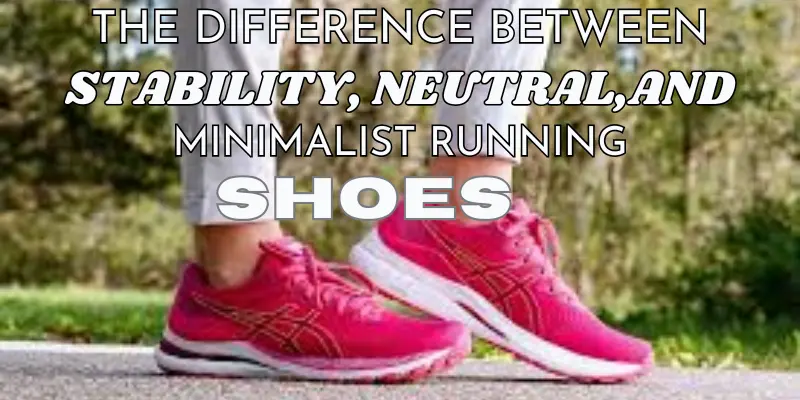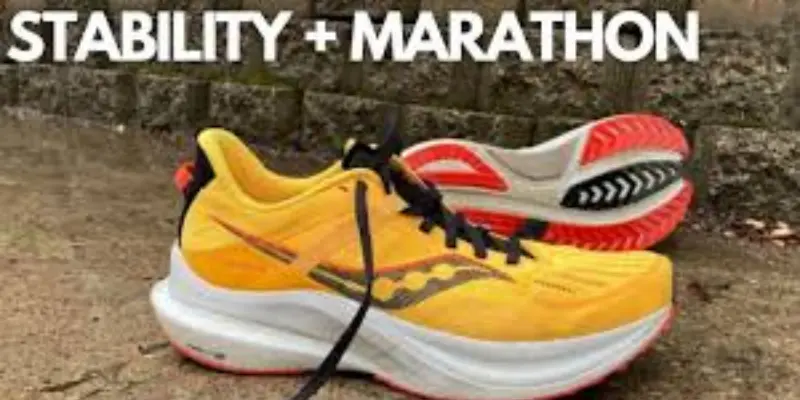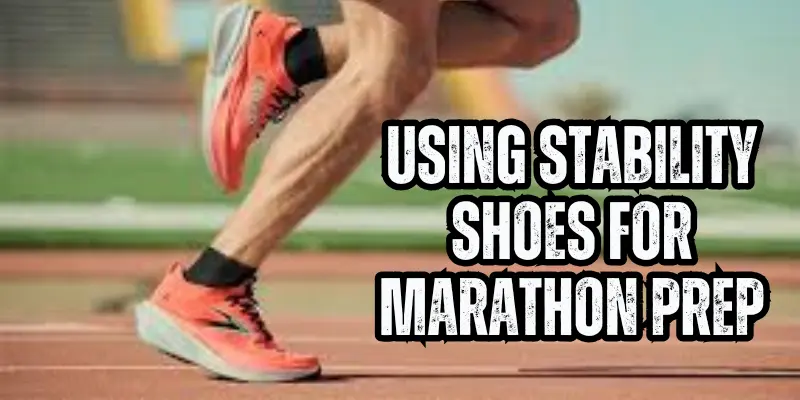Best Stability Shoes for Marathon Runners 2025
Published: 3 Aug 2025
🏁 What to Know First
Marathon running takes serious commitment—and the right shoes make all the difference. If your feet roll inward when you run (overpronation), you need more than just comfort. You need stability running shoes built for long miles. These shoes add arch support, control motion, and help prevent injuries like shin splints or knee pain.

Whether you’re new to distance running or training for your next big race, this guide will help you find the best stability shoes for marathon training and racing. We’ll keep it simple, clear, and packed with real advice to get you moving safely and confidently.
👟 1. How Stability Shoes Work
Your feet move a lot when you run. For some people, the feet roll too far inward—this is called overpronation. It can cause sore knees, shin splints, or even injuries over time.
Stability running shoes are made to fix that. They have special support on the inside of the shoe (called medial support) that keeps your feet in line. They also have soft but firm cushioning to absorb shock and keep you steady on long runs.

Example: Jake, a first-time marathon runner with flat feet, couldn’t train past 5 miles without pain—until he switched to stability shoes. Problem solved.
🧩 2. Key Features to Look For in Marathon Stability Shoes
Choosing the right stability shoes for marathon running isn’t just about comfort—it’s about support, balance, and durability. Here’s what to look for:

- Arch Support
If you have flat feet or overpronate, strong arch support helps align your stride and prevent joint pain. - Midsole Tech
Look for features like GuideRails (Brooks), FF Blast (ASICS), or J-Frame (HOKA). These guide your foot and reduce extra movement. - Cushioning vs Responsiveness
Some shoes feel soft and protective, others feel fast and springy. The best marathon shoes strike a balance. - Durability
Pick a pair that can handle high mileage for training and another for race day if needed.
👟 3. 2025’s Top Stability Shoes for Marathon Runners
Here are some of the best stability running shoes for marathon runners in 2025. Each one offers a mix of support, cushioning, and durability to keep you moving comfortably from start to finish.

ASICS Gel-Kayano 32
Pros: Plush cushioning, great arch support, durable for long training blocks
Cons: Slightly heavy for race day
Best For: Runners who want max comfort and stability for high mileage
Brooks Adrenaline GTS 23/24
Pros: GuideRails system for smooth motion control, comfortable fit
Cons: Less responsive than some lighter models
Best For: Daily training, flat-footed runners, and those with mild knee issues
Saucony Tempus / Guide 17
Pros: Lightweight, responsive feel, energetic ride
Cons: Tempus may feel firm for runners who prefer plush cushioning
Best For: Runners who want speed without losing support
HOKA Arahi 7
Pros: Rocker sole for smooth transitions, lightweight, soft cushioning
Cons: Less structure for severe overpronators
Best For: Marathoners needing joint-friendly support without bulk
Puma ForeverRun Nitro 2
Pros: Balanced cushioning, sleek design, good for long runs
Cons: Newer to the market, less proven in ultra-long races
Best For: Runners seeking a versatile, stylish option for both training and racing
Each of these shoes supports overpronation, delivers solid arch support, and suits different training styles—from easy miles to race day.
📊 4. Comparison Table: 2025’s Best Stability Shoes for Marathon Runners
Here’s a quick side-by-side to help you choose the right shoe based on your needs—whether it’s long training runs, race day comfort, or overall support for overpronation.
| Shoe Model | Price (USD) | Support Level | Best For | Weight (Men’s US 9) | Cushioning | Surface Type |
| ASICS Gel-Kayano 32 | $160–$170 | High | High-mileage training, flat feet | ~10.7 oz | Plush | Road |
| Brooks Adrenaline GTS 24 | $140–$150 | Moderate-High | Daily training, mild knee pain | ~10.1 oz | Balanced | Road, light gravel |
| Saucony Tempus | $160 | Moderate | Responsive long runs, race day | ~8.9 oz | Springy | Road |
| Saucony Guide 17 | $140 | Moderate | Budget-friendly training stability | ~9.5 oz | Soft | Road |
| HOKA Arahi 7 | $145 | Moderate | Joint pain relief, long steady runs | ~9.3 oz | Soft | Road |
| Puma ForeverRun Nitro 2 | $150 | Moderate | Stylish all-rounder, long runs | ~9.4 oz | Balanced/Soft | Road |
💡 Tip: Choose plush cushioning for comfort during long training blocks, and consider a lighter model like the Tempus for race day speed without sacrificing support.
👣 5. Choosing the Right Shoe Based on Your Foot Type
Not all feet are the same—and your foot shape plays a big role in choosing the best stability running shoes for marathon training.

- Flat Feet
If your arch touches the ground fully, you likely overpronate. Go for shoes with strong arch support and firm medial stability, like the Brooks Adrenaline GTS or ASICS Gel-Kayano. - High Arches
You may not overpronate, but you still need cushioning. Some stability shoes offer a balance of support and flexibility, like the Saucony Tempus. - Wide Feet
Look for shoes that come in wide options—like New Balance 860v13 or HOKA Arahi—to avoid rubbing or toe crowding.
Tip: Try the wet test at home. Step on a paper bag with wet feet. A full imprint = flat feet. A skinny middle = high arches. Or better yet, get a free gait analysis at a local running store. It’s quick and super helpful.
🏃♀️ 6. Training Tips: Using Stability Shoes for Marathon Prep
Stability shoes are great for support—but to get the most out of them during marathon prep, you need to train smart. Here’s how:

- Break Them In Gradually
Don’t run 10 miles on day one. Start with short runs (2–4 miles) to let your feet adjust. Even the best stability shoes for marathon running need a break-in period. - Rotate Your Shoes
Use one pair for daily training and another for race pace runs or long efforts. For example: Brooks Adrenaline GTS for training, Saucony Tempus for race day. - Track Mileage
Most shoes last 300–500 miles. Use a running app or write the purchase date inside the tongue. Wearing worn-out shoes increases your injury risk—even with good arch support.
Smart rotation and tracking keep your body and shoes in top shape.
⚠️ 7. Mistakes to Avoid When Buying Stability Shoes
Buying the wrong pair of stability running shoes can mess up your marathon training. Here are some common mistakes beginners make—and how to avoid them:
- Choosing Price Over Fit
A cheaper shoe might save money upfront but cost you in discomfort or injury later. Fit and support matter more than the price tag. - Not Testing Them on a Run
Walking around the store isn’t enough. Try jogging in them—many stores have return policies. You need to feel how the arch support and cushioning hold up under motion. - Ignoring Wear and Tear
Worn-out shoes lose stability and cushioning. If you see uneven soles or feel new aches, it’s time for a new pair—even if they look okay.
Smart choices now will save you pain later.
🏁 8. Conclusion
Choosing the best stability shoes for marathon training isn’t about picking the most expensive pair—it’s about finding what fits your stride, foot type, and training style. Look for arch support, the right midsole tech, and a balance between cushioning and responsiveness that works for you.
Don’t rush the process. A well-fitted stability shoe can reduce pain, prevent injuries, and help you run longer, stronger, and more confidently. Remember: comfort leads to consistency, and consistency is what gets you across the finish line.
Ready to train smart? Lace up the right pair—and go get that marathon.
❓ 9. FAQs
Not necessarily. If your feet stay neutral when you run, a neutral running shoe may be better. But if you feel knee or arch pain, mild stability shoes with soft support could still help—especially on long marathon runs.
Yes, many runners race in stability shoes, especially if they need support. Lightweight models like the Saucony Tempus or Puma ForeverRun Nitro 2 offer a balance of cushioning, responsiveness, and control—perfect for race day.
Most stability running shoes last between 300 and 500 miles, depending on your running style, weight, and surface. Keep an eye on the outsole wear and how the cushioning feels. If they feel flat, it’s time to replace them.

- Be Respectful
- Stay Relevant
- Stay Positive
- True Feedback
- Encourage Discussion
- Avoid Spamming
- No Fake News
- Don't Copy-Paste
- No Personal Attacks



- Be Respectful
- Stay Relevant
- Stay Positive
- True Feedback
- Encourage Discussion
- Avoid Spamming
- No Fake News
- Don't Copy-Paste
- No Personal Attacks





